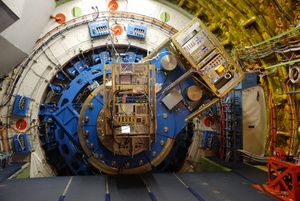by Veronika Meduna

The modified SOFIA aircraft, which carries the telescope inside the large opening in its side, at Christchurch airport (image: NASA/USRA)
Astronomers, technicians and engineers from the United States and Germany have gathered in Christchurch to take part in a series of flights aboard a modified aircraft that carries the world’s largest airborne observatory.
SOFIA, which stands for the Stratospheric Observatory for Infrared Astronomy, has been deployed to Christchurch to study space objects that are best observed from the Southern Hemisphere. A joint project between NASA and the German Aerospace Center DLR (Deutsches Zentrum für Luft- und Raumfahrt), SOFIA carries a 2.5-metre telescope in a modified Boeing 747 special-performance aircraft. The plane flies at altitudes as high as 13,700 meters to provide access to astronomical signals at far-infrared wavelengths that would otherwise be blocked because water vapour in the atmosphere absorbs in the infrared spectrum.
 During the southern flights, the telescope carries a spectrometer called GREAT, or the German Receiver for Astronomy at Terahertz Frequencies (right), which has already been used on missions in the Northern Hemisphere where it has helped astronomers to observe the formation of a star and to detect new molecules in space.
During the southern flights, the telescope carries a spectrometer called GREAT, or the German Receiver for Astronomy at Terahertz Frequencies (right), which has already been used on missions in the Northern Hemisphere where it has helped astronomers to observe the formation of a star and to detect new molecules in space.
The scientific targets for SOFIA's southern deployment include objects in the central regions of the Milky Way, which are much more accessible from the Southern Hemisphere, and the Large and Small Magellanic Clouds, which are easily visible with the naked eye in the southern sky. Their relative proximity allows the detailed investigation of stellar life cycles, from protostars to supernova remnants.
SOFIA has already flown the first of nine planned missions last week, exploring the Magellanic Clouds and the disk of dust and gas orbiting the black hole in the centre of our galaxy.

Some targets of astronomical interest are only visible from the Southern Hemisphere. This image of the southern sky, taken at Cerro Paranal in the Chilean Atacama Desert, shows a total of three galaxies: our Milky Way and the two Magellanic Clouds. (image: ESO/Y. Beletsky)

